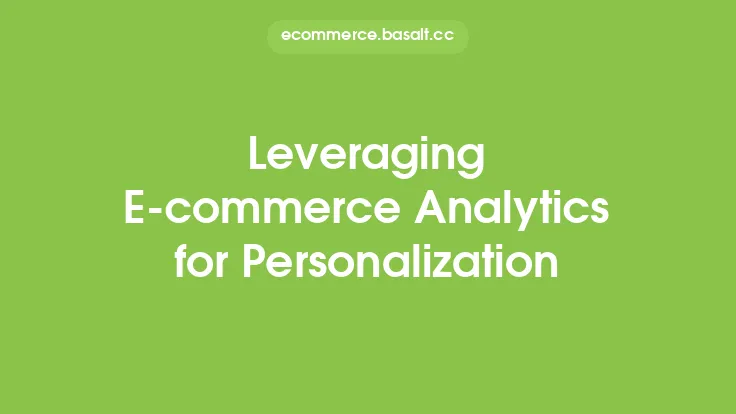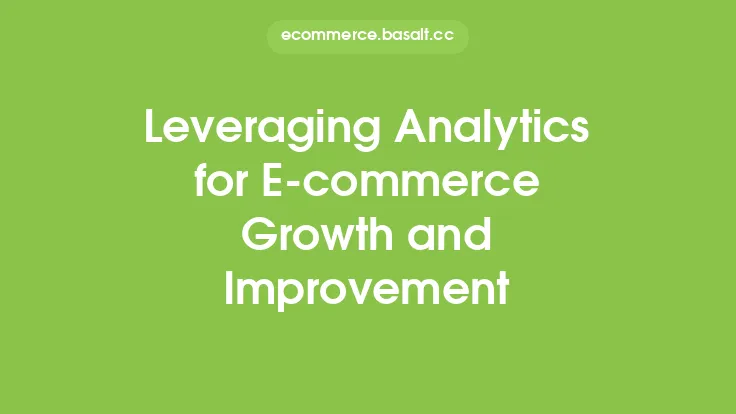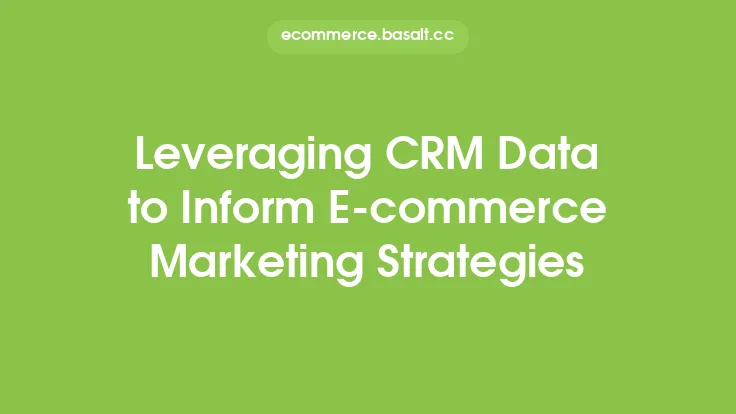In the world of e-commerce, data is king. With the vast amounts of information available, online retailers can gain valuable insights into customer behavior, preferences, and shopping habits. By leveraging e-commerce data, businesses can create personalized experiences that drive sales, increase customer loyalty, and ultimately, boost revenue. In this article, we will explore the ways in which e-commerce data can be used to inform personalization and sales strategies, and provide actionable tips for businesses looking to get the most out of their data.
Introduction to E-commerce Data
E-commerce data refers to the vast amounts of information collected from online transactions, customer interactions, and website behavior. This data can include everything from demographic information and browsing history to purchase patterns and customer feedback. By analyzing this data, businesses can gain a deeper understanding of their customers and create targeted marketing campaigns, personalized product recommendations, and optimized website experiences.
Types of E-commerce Data
There are several types of e-commerce data that businesses can collect and analyze, including:
- Transactional data: This includes information about customer purchases, such as order value, product categories, and payment methods.
- Behavioral data: This includes information about how customers interact with a website, such as browsing history, search queries, and click-through rates.
- Demographic data: This includes information about customer demographics, such as age, location, and income level.
- Feedback data: This includes information about customer satisfaction, such as product reviews, ratings, and complaints.
Collecting and Analyzing E-commerce Data
To collect and analyze e-commerce data, businesses can use a variety of tools and techniques, including:
- Web analytics software: This includes tools like Google Analytics, which provide insights into website traffic, behavior, and conversion rates.
- Customer relationship management (CRM) software: This includes tools like Salesforce, which provide insights into customer interactions, preferences, and purchase history.
- Data mining software: This includes tools like SQL, which provide insights into large datasets and enable businesses to identify patterns and trends.
- Machine learning algorithms: This includes tools like predictive modeling, which enable businesses to forecast customer behavior and personalize recommendations.
Personalization Strategies
By analyzing e-commerce data, businesses can create personalized experiences that drive sales and increase customer loyalty. Some effective personalization strategies include:
- Product recommendations: By analyzing customer browsing history and purchase patterns, businesses can recommend relevant products and increase average order value.
- Content personalization: By analyzing customer demographics and preferences, businesses can create targeted content that resonates with their audience and increases engagement.
- Email marketing: By analyzing customer behavior and preferences, businesses can create targeted email campaigns that drive conversions and increase customer loyalty.
- Website optimization: By analyzing customer behavior and feedback, businesses can optimize their website experience and increase conversion rates.
Sales Strategies
By analyzing e-commerce data, businesses can also create targeted sales strategies that drive revenue and increase customer loyalty. Some effective sales strategies include:
- Upselling and cross-selling: By analyzing customer purchase patterns and preferences, businesses can recommend relevant products and increase average order value.
- Discounts and promotions: By analyzing customer behavior and preferences, businesses can create targeted promotions that drive conversions and increase customer loyalty.
- Loyalty programs: By analyzing customer behavior and preferences, businesses can create loyalty programs that reward customers for repeat purchases and increase customer retention.
- Retargeting: By analyzing customer behavior and preferences, businesses can create targeted retargeting campaigns that drive conversions and increase customer loyalty.
Best Practices for Leveraging E-commerce Data
To get the most out of e-commerce data, businesses should follow best practices such as:
- Collecting and analyzing data from multiple sources: This includes combining data from web analytics software, CRM software, and data mining software to gain a comprehensive understanding of customer behavior.
- Using data to inform decision-making: This includes using data to inform marketing campaigns, product development, and website optimization.
- Creating a data-driven culture: This includes encouraging employees to use data to inform decision-making and drive business outcomes.
- Protecting customer data: This includes ensuring that customer data is secure and compliant with relevant regulations, such as GDPR and CCPA.
Common Challenges and Solutions
Despite the many benefits of leveraging e-commerce data, businesses may face common challenges such as:
- Data quality issues: This includes ensuring that data is accurate, complete, and up-to-date.
- Data silos: This includes ensuring that data is integrated across multiple systems and departments.
- Lack of resources: This includes ensuring that businesses have the necessary skills, tools, and budget to collect and analyze e-commerce data.
- Balancing personalization and privacy: This includes ensuring that businesses balance the need for personalization with the need to protect customer privacy and comply with relevant regulations.
Future of E-commerce Data
The future of e-commerce data is exciting and rapidly evolving. With the rise of emerging technologies such as artificial intelligence, machine learning, and the Internet of Things, businesses will have access to even more data and insights than ever before. Some potential trends and innovations include:
- Increased use of AI and machine learning: This includes using AI and machine learning to analyze e-commerce data and create personalized recommendations.
- Greater emphasis on customer experience: This includes using e-commerce data to create seamless and personalized customer experiences across multiple channels and touchpoints.
- Increased focus on data privacy and security: This includes ensuring that businesses prioritize data privacy and security in the face of emerging regulations and technologies.
- Greater use of real-time data: This includes using real-time data to inform decision-making and drive business outcomes in real-time.





